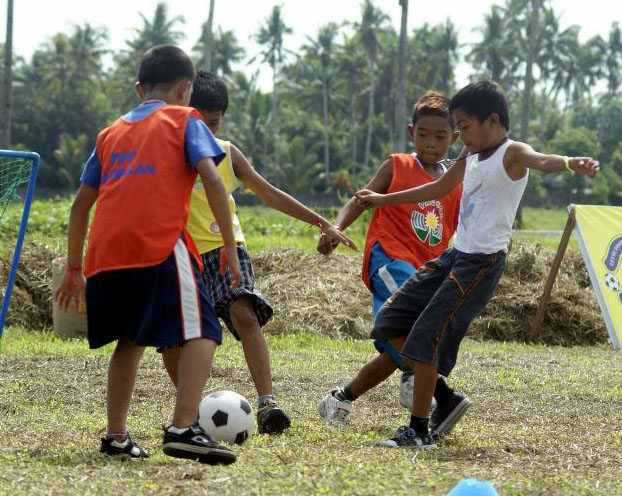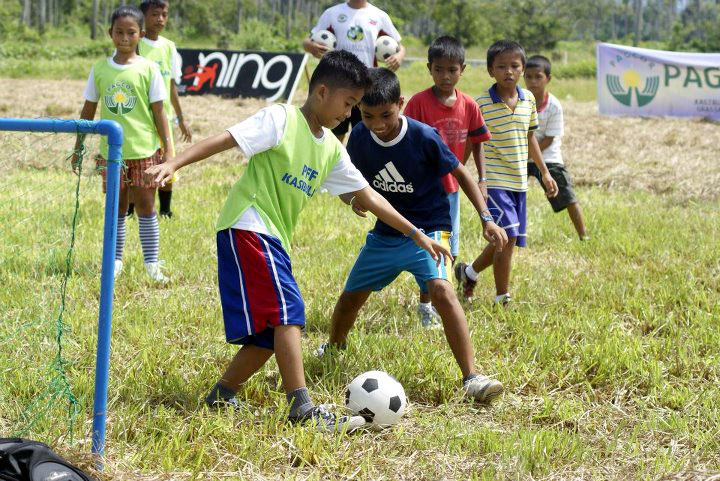Filtered By: Sports
Sports
ANALYSIS: Beyond the Azkals, lessons for developing grassroots football
By ROY MOORE

Kids playing at a PFF Kasibulan camp in Leyte.
This is the second in a series on the future of the Azkals and Philippine football. For the first part, click here.
Building grassroots, infrastructure, and facilities are all very long-term projects. That’s why it’s important to keep context in mind, as Philippine Football Federation (PFF) general secretary Ed Gastanes notes: "Football was not in the national consciousness." Indeed, before the Azkals' rise, it was virtually anonymous.
So what is the PFF doing to build grassroots? Kasibulan is the flagship project. On Day 1, they train teachers, Day 2 the teachers coach kids, Day 3 the kids play in a festival. The unpublished report for the second half of 2014 says 1,654 teachers joined the training, to coach 10,271 kids, through 44 festivals. As Gastanes says, “The idea is to give the kids a real tournament to play… in addition to the local tournaments”.
Kasibulan is a short-term project primarily about raising awareness and interest. It’s not long-term because festivals are one day events, and because it’s funded by PAGCOR, so once PAGCOR funding ends presumably so does Kasibulan.
The PFF therefore also do coaching courses. These have been very successful in raising the number of licensed coaches across the Philippines. The PFF's rationale is "to have quality players you must have quality coaches." This increase will cause a ripple effect, graduates from provinces can hold coaching courses in those provinces. "If we localise we will cut the expense, so we can do more courses," says Gastanes.
The increase in licensed coaches is tangible, useful, and somewhat long-term, because the coaches will always be licensed. Though as Atty. Ed bemoaned, many of these coaches are hired by schools.
Nowhere to play
The big edge for the schools? Facilities. These schools have a budget for sports, and typically have their own pitches. And that underlines the deeper problem with grassroots football today. In the typical barangay right now, if a kid wants to play football he can’t. Basketballers fill the local court, the streets are crowded and unsafe, and to join a team on a football pitch costs roughly P500 per session — plus kits, spikes, and other equipment. To their credit, some academies have taken in kids from poor communities, but there’s still nowhere for the typical kid to play in their own barangay.
This is also why the Kasibulan numbers don’t say everything. It may reach 10,271 kids, but that’s for one day. How many of those kids have anywhere to play tomorrow? One wonders if investing in facilities would be a better way to go.
If you built a futsal court for 100 kids — one percent of the Kasibulan’s figures — it would take 102 days for them to play as much football as every one of the 10,271 did. But a single futsal court in an area where kids want to play football can be more effective than the entire festival scene in that respect.
On facilities, though, the PFF is clear. "We don’t really have funds to be building facilities like that," says Gastanes. "The position of the PFF right now is to encourage private individuals to build mini-pitches and football pitches… as a business proposition”. He suggested the return on investment for a pitch is three years.
So if it’s such a quick return on investment, why wouldn’t the PFF jump at the chance to build their own facilities? It would create annual funds for the PFF while simultaneously developing footballers.
The answer is that all funding is tied to facilities for the Azkals.
"For the PFF, we are focused on the national team’s training center," Gastanes says, adding that the Azkals previously did "not even own its own training pitch."
The national team training center will be in San Lazaro, Carmona, Cavite, while another full size artificial pitch for the national team will be in Tacloban via FIFA’s GOAL project.

Kids playing at a PFF Kasibulan camp in Leyte.
From grassroots to national
To be fair, projects like Kasibulan, the coaching courses, and the planned facilities are better than what came before.
But long term, the PFF are looking to the national league.
"You have to link [grassroots] to the national league. You cannot have sustained youth development without the national league," says Gastanes. To him, the national league is the answer to all of my questions about long-term development, and to a degree serious grassroots development is delayed until then.
While a national league would be amazing, and I certainly hope it works out, I have to respectfully disagree with the PFF here. It’s not that the national league will build grassroots, it’s that grassroots will build the national league. A national league sits at the top of the pyramid, and you can’t support the top without the foundations. A young generation of footballers creates the players and the market; they become the fans who understand football, watch the games, and buy the merchandise.
Bottom-up approaches take longer, though, and that’s why everything right now is top-down.
This is why the loss to Thailand in the 2014 Suzuki Cup is a wakeup call. It showed how the vision for Philippine football needs to really be long term, and how much work still needs to be done.
Model league
With all the talk about the national league, the Philippines can learn much from Japan's experience with the J-League. From the very start, the focus was on the youth, as Scott McIntyre documented in his series on the rise of Japanese football.
When the J-League kicked off in 1993, the groundwork had been completed, which included how clubs had to have youth teams. "Players were dispatched into schools en-masse to spread the message," wrote McIntyre, underlining the league's emphasis on the youth.
This focus is shown in the example of one particular coaching session. With the likes of Zinedine Zidane on the field, the crowd were cheering for ‘Tom-san’, Tom Byer, an American coach who helped revolutionize Japanese football.
As Matthew Hernon wrote in the Tokyo Weekender, Byer appeared regularly on the top children’s TV show in the country to do a skill’s segment, and appeared monthly in the Manga CoroCoro, which had a circulation of 1.2 million. He helped launch the football video game Inazuma Eleven, wrote plenty of articles for the media, and his Football Technics was the number one selling DVD in the country. Through focus on technical development at a young age, Byer got kids hooked on football
As Matthew Hernon wrote in the Tokyo Weekender, Byer appeared regularly on the top children’s TV show in the country to do a skill’s segment, and appeared monthly in the Manga CoroCoro, which had a circulation of 1.2 million. He helped launch the football video game Inazuma Eleven, wrote plenty of articles for the media, and his Football Technics was the number one selling DVD in the country. Through focus on technical development at a young age, Byer got kids hooked on football
As the kids developed, Japan’s organization made sure they made use of every talent. "Japan is the most organised federation anywhere in the world. Such is the strata they have in place that it’s almost impossible for a good player not to get seen," wrote Byer. "It has a bit to do with the demographics in that it’s an island country, there’s 47 prefectures and all these players whether it’s Kagawa or Honda… are almost guaranteed to have been playing in the national training centers for years."
Japan recognized that the youth were the foundation for a sustainable league. The result? Japan won their first Asian Cup in 1992 as J-League preparations took hold and they qualified for their first World Cup in 1998. They’ve qualified for every World Cup since and won three of four Asian Cups leading into the 2015 tournament — where they just suffered a surprise penalty loss to United Arab Emirates in the quarterfinals. Nonetheless, Japanese talents such as Shinji Kagawa, Kaisuke Honda, and Shinji Okasaki remain some of the top players in Asia, and there’s plenty more coming through the youth ranks.
Of course, there are some things in all this that the Philippines can’t copy. The marketing budget for the Philippine national league (P-League anyone?) will be nowhere close to what Japan poured in. Likewise, there are plenty of other lessons on offer which I don't have space to discuss.
Most relevant for Philippine football, though, are two underlying points to all the success stories around the football world: community identity as the basis for clubs, and youth as the target audience.
The first, community, is shaping up well with provincial rivalries touted as the identity behind the national league. The second, youth development, is worryingly sparse. Should we choose not to make youth the target audience for the national league, its future will be in real peril before it’s even begun. — JST, GMA News
Part 3 will tackle how to apply these lessons to a Philippine context, how futsal could be the key to unlocking our football development, and how the 10,000 hour rule underlines it all.
Part 3 will tackle how to apply these lessons to a Philippine context, how futsal could be the key to unlocking our football development, and how the 10,000 hour rule underlines it all.
More Videos
Most Popular




